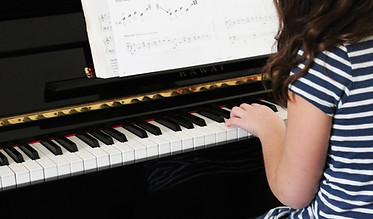
951-551-7162
Private Instruction
Personal Attention

"What I have in my heart and soul -- must find a way out. That's the reason for music." -- Ludwig van Beethoven
In my studio, I use an integrated curriculum that is essential in developing technical skills, sight reading and strengthening aural skills for a well-rounded music education. Each lesson involves an element of learning and theory being put into practice.
LEARNING BY EAR AND ROTE
Music is an aural art. We hear the sound of music and learn to sing songs just from listening. Even before we learn to read or write, we learn to speak by listening and imitating what we hear. Listening strengthens aural skills. Students learn to play simple tunes before note reading is introduced through rote playing. Without the distraction of note reading which can be overwhelming for beginners, students are able to focus on memory, technical and aural skills. Progress is faster and much more difficult and showy pieces are learned in less time. Students are taught the basics of melody, harmony, chord shapes and musical patterns. They are also encouraged to explore, create and improvise.
SIGHT READING MUSIC
Teaching students to read music is the traditional approach most commonly used by piano teachers. Progress is slow in the beginning because of the complexities of having to read symbols especially for really young beginners. Learning to read music is like learning a foreign language. Some benefits of being able to sight read musical notation fluently makes it accessible for a student to play and enjoy different genres of music quicker. Thus, an understanding of written music makes communicating easier with fellow musicians.
So, you can play Beethoven & Mozart Sonatas...how about a simple "Happy Birthday" arrangement by ear?
Although the ability to read music has many benefits, studies have shown that most classically-trained pianists have become so dependent on written music. This is a result of majority of piano teachers discouraging students from playing by ear and defaulting to the method they were taught. After years of formal piano lessons, many students may be able to play difficult repertoire but when asked to play a simple and familiar tune like "Happy Birthday", they're likely unable to do so without the written music. Oftentimes, the inability to play the piano without the music mapped out in the form of what we call "sheet music" seemed almost paralyzing. How crippling is that? The piano all of a sudden is like a foreign instrument. While the goal is to eventually read music fluently which I strongly emphasize, music activities should include some kind of creativity. I feel that students benefit greatly when they can experience creativity in music making by incorporating playing by ear and improvisation as part of the curriculum. Embracing a combination of the above approach enhances learning and makes the process enjoyable. I believe that students should be able to EXPLORE, EXPERIENCE & ENJOY piano lessons where creativity matters.
"Music gives a soul to the universe, wings to the mind, flight to the imagination and life to everything."-- Plato